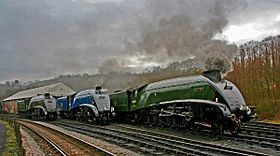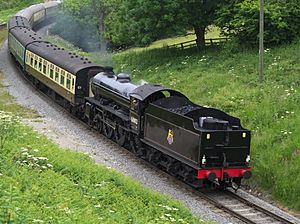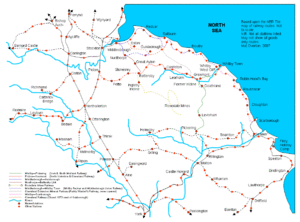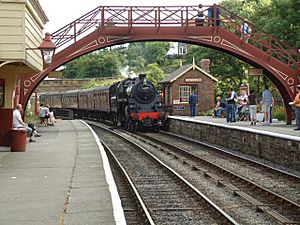North Yorkshire Moors Railway facts for kids
Quick facts for kids North Yorkshire Moors Railway |
|
|---|---|

Three LNER Class A4 locomotives at Grosmont loco shed in 2008.
|
|
| Locale | North Yorkshire |
| Terminus | Whitby and Pickering |
| Connections | Network Rail (at Grosmont) |
| Commercial operations | |
| Name | North Eastern Railway |
| Built by | George Stephenson |
| Original gauge | 4 ft 8 1⁄2 in (1,435 mm) standard gauge |
| Preserved operations | |
| Operated by | North Yorkshire Moors Railway Enterprises Plc |
| Stations | 6 (Including Whitby) |
| Length | 18 miles (29 km) 24 miles (39 km) when extended over Network Rail metals to Whitby |
| Preserved gauge | 4 ft 8 1⁄2 in (1,435 mm) standard gauge |
| Commercial history | |
| Opened | 1836 |
| Closed | 1965 |
| Preservation history | |
| 1967 | NYMR Preservation Society formed |
| 1 May 1973 | NYMR reopened |
| 1975 | Pickering re-opened officially |
| 1981 | Newton Dale halt opened to the public |
| 2007 | Some services extended to Whitby |
| 2012 | Pickering railway station re-roofed (station roof re-instated) for the first time in 60 years. |
| Headquarters | Pickering, North Yorkshire |
| Website | |
| www.nymr.co.uk | |
The North Yorkshire Moors Railway (NYMR) is a special heritage railway in North Yorkshire, England. It runs right through the beautiful North York Moors National Park. This railway first opened way back in 1836. It was originally called the Whitby and Pickering Railway.
The famous engineer George Stephenson planned the railway in 1831. His idea was to create new trade routes from the important seaport of Whitby. The line between Grosmont and Rillington closed in 1965. However, the section between Grosmont and Pickering was reopened in 1973. This was thanks to the North York Moors Historical Railway Trust Ltd.
Today, the preserved railway is a very popular place for tourists. It has even won several awards for its great work. Since 2007, the railway has also run regular trains to Whitby. This journey covers about 6 miles of the Esk Valley Line. In 2014, a second platform opened at Whitby. This allowed more trains to run and helped nearly 350,000 people visit that year.
The railway is about 24 miles long. It is run by a charity and has 100 full-time staff, 50 seasonal staff, and over 550 volunteers. These dedicated people help keep the trains running. In 2020, the NYMR was called the UK's most popular heritage railway.
Contents
Discover the North Yorkshire Moors Railway
The North Yorkshire Moors Railway carries more passengers than any other heritage railway in the UK. It might even be the busiest steam heritage line in the world. In 2010, it carried 355,000 passengers!
This 18-mile railway is the third-longest standard gauge heritage line in the UK. It runs across the stunning North York Moors National Park. The journey takes you from Pickering through Levisham, Newton Dale, Goathland, and ends at Grosmont.
Some trains even continue along the national railway tracks to Whitby. The NYMR uses the middle part of the old Whitby, Pickering and Malton Line. This line closed in 1965 because of the Beeching cuts.
The North York Moors Historical Railway Trust Ltd owns the NYMR. This is a charity and a recognised museum. Its company, North Yorkshire Moors Railway Enterprises plc, operates the railway. Most of the work is done by amazing volunteers.
Trains usually run daily from April to October. They also run on weekends and some holidays in winter. There are no services from December 24 to 27. Most trains are pulled by steam engines. However, sometimes older diesel engines are used. During busy times, trains leave each station every hour. Besides regular trips, you can also enjoy special dining services on some evenings and weekends. The steam train trips to the seaside town of Whitby are very popular.
Journey Through Time: The Railway's History
The North Yorkshire Moors Railway first opened in 1836. It was known as the Whitby and Pickering Railway. George Stephenson planned it in 1831. He wanted to create trade routes from the important port of Whitby.
The first railway was built for horse-drawn carriages. Workers called navvies built it, guided by top engineers. They made a 120-yard tunnel through rock at Grosmont. They also built a rope system at Beck Hole. And they crossed the wet Fen Bog using timber and sheep fleeces. This tunnel is one of England's oldest railway tunnels.
In its first year, the railway carried 10,000 tonnes of stone. It also carried 6,000 passengers. A ticket to sit on the roof cost 1 shilling. To sit inside, it was 1 shilling and 3 pence. The trip from Whitby to Pickering took two and a half hours.
In 1845, the York and North Midland Railway bought the line. They rebuilt it for steam locomotives. They also built the permanent stations and buildings you see today. The Beck Hole incline got a new steam engine and iron rope. They also added a line south from Pickering to connect to York.
The North Eastern Railway took over in 1854. Steam locomotives could not use the Beck Hole incline. So, in the early 1860s, a new route was built. This new route opened in 1865 and is still used today. The original route is now a 3.5-mile walking path called the Rail Trail.
In 1923, the North Eastern Railway became part of the London and North Eastern Railway. Then, in 1948, British Railways took control. Not much changed on the line during this time. However, a report by Dr. Beeching said the Whitby-Pickering line was not making money. It was listed for closure. The last passenger train ran on March 6, 1965. Freight trains stopped in July 1966.
In 1967, the NYMR Preservation Society was formed. They started talks to buy the line. After some special open weekends in the early 1970s, the society became a charity. This ensured the railway's future. It became The North York Moors Historical Railway Trust Ltd in 1972. They bought the line and got permission to run the railway.
The railway reopened in 1973 as the North Yorkshire Moors Railway. Many of the engines were provided by the North Eastern Locomotive Preservation Group.
Running trains to Whitby was also a dream. In 1987, the famous 92220 Evening Star ran a service to Whitby. Regular trains started running from Grosmont to Whitby in 2007. This meant the whole original Whitby and Pickering Railway line was open again. In 2014, a second platform at Whitby allowed more trains to run. This led to 120,000 people travelling to Whitby that year. Overall, the railway attracted nearly 350,000 visitors in 2014.
The preserved railway is now a popular tourist spot. It has won many awards for tourism and heritage.
In 2017, the NYMR received a large grant from the National Lottery Heritage Fund. This money helped renew old bridges and build a new carriage shed at Pickering. In 2021, the railway also received a grant from the government's Culture Recovery Fund.
During the COVID-19 pandemic in 2020 and 2021, the railway had to close for months. A special appeal raised over £400,000 in donations. The 2020 season was delayed, and events were cancelled.
A new facility for storing 40 carriages opened in September 2021.
On June 12, 2023, King Charles III visited Pickering station. He arrived on the British Royal Train, pulled by the famous LNER Class A3 4472 Flying Scotsman locomotive. This visit celebrated the locomotive's 100th birthday and the railway's 50th anniversary of being run by volunteers. The King had visited before in 2000.
Stations Along the Line
| Point | Coordinates (Links to map resources) |
OS Grid Ref | Notes |
|---|---|---|---|
| Pickering | 54°14′50″N 0°46′43″W / 54.2471°N 0.7785°W | ||
| Levisham | 54°18′30″N 0°44′39″W / 54.3082°N 0.7443°W | ||
| Newton Dale Halt | 54°20′33″N 0°43′03″W / 54.3424°N 0.7176°W | ||
| Goathland | 54°24′00″N 0°42′43″W / 54.400°N 0.712°W | ||
| Grosmont | 54°26′10″N 0°43′30″W / 54.4360°N 0.7250°W | ||
| Grosmont (Network Rail) | 54°26′11″N 0°43′31″W / 54.4364°N 0.7254°W | NYMR trains do not use platform 1 | |
| Whitby (Network Rail) | 54°29′06″N 0°36′55″W / 54.4849°N 0.6152°W | NYMR trains run over Network Rail tracks to Whitby |
- Pickering is where the railway journey begins in the south. This station has been restored to look like it did in 1937. It has original ticket offices and a tea room. There's also a park-and-ride service to help with traffic. Pickering is home to the railway's carriage workshops and a turntable for turning engines around. A new roof was added to the station in 2011, just like the original one. The station also has a learning centre and a visitor centre.
- Levisham is a small station in the countryside. It's almost 2 miles from the village it serves. This area is great for walking and seeing wildlife and flowers. Levisham Station looks like a small NER country station from around 1912. You can even stay in a traditional camping coach here for holidays.
- Newton Dale Halt is a remote stop for walkers in Cropton Forest. You can find many forest walks of different lengths here.
- Goathland looks almost the same as when it was built in 1865. It has been restored to look like an NER country station from around 1922. This station is very popular because it appeared in the TV show Heartbeat and the first Harry Potter film. It has a newly updated tea room inside an old goods warehouse. You can also rent a traditional camping coach here.
- Grosmont was the northern end of the railway until 2007. That's when trains started going to Whitby regularly. The engine sheds are here, just south of a tunnel. The station itself looks like it did in 1952 during the British Railways era. It has a shop, café, toilets, ticket office, and waiting room. The shed area provides water and coal for the engines. You can often see engines that are not in service or being repaired in the running shed. Grosmont connects with the Network Rail line. Passengers can change trains here to go to Whitby or Middlesbrough.
- Whitby is often the northern end of the railway. Steam trains usually run all the way from Pickering to Whitby, especially in July and August. If NYMR trains stop at Grosmont, you can usually catch a connecting train to Whitby. Whitby station has a ticket office and shop. In August 2014, a second platform opened here for the NYMR's trains.
Locomotives
Future Plans and Improvements
People often talk about reopening the 8-mile section between Malton and Pickering. This would allow steam trains to run from York to Whitby again. However, this would need a lot of work. Houses and a supermarket have been built on the old track.
The North Yorkshire County Council once supported reopening this link. The NYMR Trust agreed in principle but worried about the high costs and how it might affect their railway. In 2014, the NYMR managing director said they did not support trains running on their tracks.
Bridge and Railway Upgrades
In 2009, the railway needed to repair a bridge near Goathland. This bridge, over Eller Beck, was very important. The railway launched an appeal to raise £1 million. They raised £610,000, and the bridge was replaced in early 2010. The first trains crossed the new bridge in March 2010.
In 2017, the NYMR started a new appeal called "Yorkshire's 'magnificent journey'". This project aimed to keep the railway running for another 50 years. It received £4.4 million in funding from the Heritage Lottery Fund.
This appeal included several important projects:
- Repairing and replacing three bridges around Goathland.
- Making it easier for everyone to access every passenger train.
- Building a new carriage shed at Pickering for up to 40 carriages.
- Creating a special education carriage at Goathland.
- Building a new hostel for volunteers at Grosmont.
- Starting programs to find and train new volunteers.
- Offering railway apprenticeship schemes for engineering training.
- Launching a project to protect the natural environment along the railway line.
In early 2021, the project also received £296,000 from the Culture Recovery Fund. Bridge 27 at Goathland was replaced in 2020. Bridges 24 and 25 were scheduled for replacement in early 2022.
Special Events and Fun Days
The NYMR hosts many special events throughout the year, often with fun themes.
- Steam Galas are weekend events, sometimes lasting longer. During these days, many trains run, including extra shuttle services and demonstration freight trains. A gala in 2008 featured three famous Gresley A4 Pacific engines, attracting thousands of visitors.
- Santa Special trains run during Christmas. They include elves, Santa's grotto, presents, and mince pies. The snowy scenery of the North York Moors National Park makes these events even more magical.
On Screen: TV and Film Appearances
The railway has been a star in many TV shows and movies!
Goathland station was used as Hogsmeade in the Harry Potter films. It also appeared in the 2016 Dad's Army film and as Aidensfield in the drama Heartbeat. Pickering station was featured in the films Possession, Keeping Mum, and Downton Abbey.
Other appearances include Casualty, Brideshead Revisited, All Creatures Great and Small, The Royal, Poirot, and the Sherlock Holmes TV series. It also appeared in the films Testament of Youth, Phantom Thread, and The Runaways.
The railway was also seen in the documentary Yorkshire Steam. It appeared in Great British Railway Journeys and the Channel 5 documentary The Yorkshire Steam Railway: All Aboard. Goathland station is in the 1985 music video for Simply Red's Holding Back the Years. The railway even featured in Thomas & Friends learning segments with LNER Class A4 60007 Sir Nigel Gresley.
The Downton Abbey film used Pickering station in its opening scene. The train was shown travelling through several communities.
In April 2021, scenes for the film Mission: Impossible – Dead Reckoning Part One were filmed at Levisham. Filming for Indiana Jones and the Dial of Destiny also took place on a section of the railway in June 2021, in the village of Grosmont.
Safety and Awards
The railway takes safety very seriously. In 2012, a volunteer was seriously injured in an accident at Grosmont. In 2021, a diesel locomotive collided with carriages at Grosmont, injuring five passengers. After this, safety rules were reviewed to make sure everyone is safe.
The NYMR has won many awards over the years. These awards celebrate its efforts in preserving railway heritage and providing a great visitor experience. Some awards include:
- 1995 Visitor Attraction of the Year (Yorkshire and Humberside Tourist Board).
- 2000 National Railway Heritage Awards for renovating the goods shed at Goathland.
- 2001 National Railway Heritage Awards for the new signal box at Grosmont.
- 2007 Best Visitor Attraction and Large Railway of the Year.
- 2010 Marketing Campaign of the Year.
- 2014 National Railway Heritage Awards for renovating the lamp room at Levisham station.
- 2015 National Railway Heritage Awards for signalling at Grosmont and for keeping its diesel fleet active.





